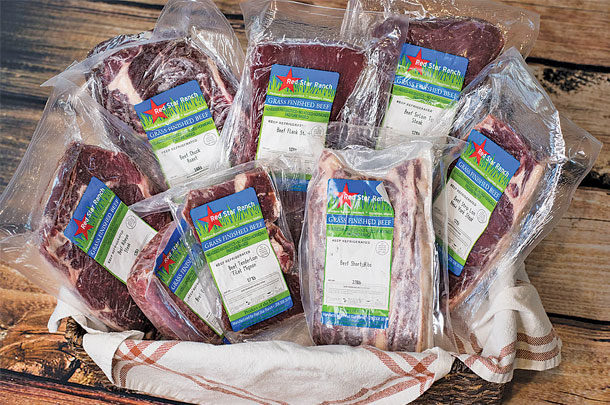Winter is a good time for reflection. The year 2020 has given us quite a bit to reflect on. As we think about the year and try to learn from it, resist the urge to look over the fence and be jealous of your neighbor who is doing “better than you.”
First of all, your neighbor is having challenges too. Secondly, I should rephrase: By all means, do look over the fence. But do so with the intent to learn, rather than become jealous. What are other people doing that you could learn from? It is easy to think you are the only one in a tough spot. But if you are a cattle producer, compare notes with someone who raises sheep.
If you raise hay in the Midwest, talk to someone out West who was ravaged by wildfire. There is always someone who fared better than you and someone who fared worse than you. Ranking yourself among others is not the point. Learning from their successes and their failures as well as your own is the best way to gain from tough experiences like 2020. How can we use what happened this year to plan for the future?
Don’t be too specific
If you make a detailed plan on what you will do the next time there is a global viral pandemic, you will probably (hopefully) never get a chance to use that plan. The set of circumstances we have just gone through have not happened in our lifetimes and may not again. But there will be other occasions when your hay customer goes broke, your cattle buyer isn’t buying or the parts store is closed.
How can you build more resilience into your operation to handle whatever challenges may arise? One way is to diversify. Many producers are questioning if they can diversify in some way. For the rest of this article, I will try to give you ideas to consider as you think about adding diversity to your operation.
Diversify what you produce
For more than a generation, farms have been becoming less diverse, not more. The thinking behind this shift was that if you specialized in what you did well, and got rid of all the distractions (also known as the diversity of the operation), you could be more productive and profitable. This system can work, but you are locked in to producing one thing. As markets change or weather happens, the best you can do is try to react to the challenges after they present themselves.
Planning for diversity changes your outlook from reactive to proactive, in many cases. Rather than playing the market and trying to sell your hay at just the right time, consulting a well-thought-out business plan with those decisions planned in advance is more stable in the long term.
In the forage realm, one way to introduce diversity is to add another class of livestock to the operation. Adding a second species of livestock to grazing systems has many advantages. Forage utilization is better, invasive species can be kept at bay and it adds a second revenue stream from a diverse market.
Another way to diversify is to sell excess forage. As you improve as a forage manager, you might find yourself in a situation where you have excess forage almost every year. Do you increase your herd, or do you plan to sell the extra forage as hay? You might argue that selling hay means you have to buy equipment or pay a custom harvester. Implied in that argument is that increasing your herd size is free. Increasing your livestock numbers might mean you have to increase infrastructure as well, which costs something. Be sure you consider all the options before saying no to diversity.
Diversify what you sell
If you diversify what you produce, you will automatically diversify what you sell. However, there are ways to sell a diverse list of items from what you are already doing. Let’s say you raise beef and currently sell all your calves via video auction. Video auctions are a great way to get a fair price for calves, but you are still dependent on feeders being willing to buy. This arrangement typically works well, but in the last year there have been some challenges. Hauling cattle to an auction yard would not help because you are still depending on feeders to buy the calves. One of the bright spots in the beef market this year has been direct marketing to consumers.
While direct marketing is not a solution for everyone, those who could take advantage of the opportunity this year saw a nice bump in revenue. Similarly, as I talk to producers who have been direct marketing for years, they noticed some interesting trends this year. Obviously, sales are strong, but also consumers have been more interested in learning where their food comes from than ever before. Seeing empty grocery shelves made consumers think more about food than they ever had. So how do you take advantage of this interest from the public? Even if you don’t want to tackle direct marketing your beef, you might be able to capture some interest in agrotourism or host educational tours.
If you already sell hay but sell only big squares, consider what adding some small squares could do. There will be investments in equipment to be sure, but selling to local small producers or to feed stores can be more secure than international markets.
As a final example, several years ago, I talked to numerous dairy farmers who made more money selling their bull calves than selling milk. Planning to breed top-end cows to generate replacement heifers while breeding the rest to beef bulls can get you more money for bull calves. Either way, bull calves are getting sold; using beef bulls just adds more value.
Beware of bottlenecks
When considering how to add diversity to your operation, consider the limitations. We often think about the financial cost of changing our businesses, but consider also how valuable your time is. Time is the most valuable asset you have. Choose how you spend it wisely. Also, consider your skill set and passion.
Is there a real market, but you just don’t have a passion for it? Maybe you are close to an urban center with a vibrant farmers’ market, but you just can’t see yourself sitting there every Thursday. If that is the thing stopping you from getting into retail sales, hire someone. We still have a very high unemployment rate, thanks to the economy being shut down. Chances are good you can find qualified workers to help with any new projects.
Adding diversity to your operation does not guarantee more profit every year, but it does help even out the highs and lows. Similar to planting a new pasture, a diverse pasture mix has more stable yields than any single pasture species planted alone. However, the pasture mix almost never yields more than the highest-producing component of that mix. The difficulty is that the same pasture species isn’t the top yielder all the time. It might be red clover one year and orchardgrass the next. Mixing red clover and orchardgrass is more consistent year after year than either one alone. Likewise, goats might be the moneymaker of your operation one year, and selling extra hay might be the ticket the following year. Predicting the future is hard; having diversity makes those predictions less critical to your success.









